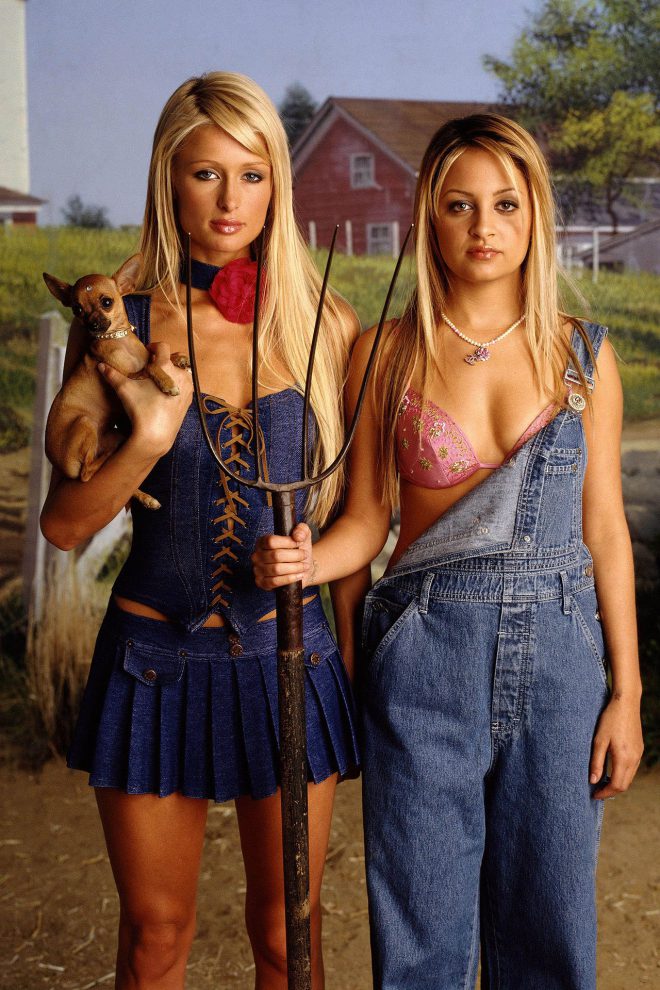Curator’s Note: “2 Freaky 2 Friday”
Amanda Brinkman, Pelican Bomb’s Creative and Operations Director, introduces “2 Freaky 2 Friday” and kicks off our editorial series exploring women’s public images.

A promotional image for Paris Hilton and Nicole Richie’s reality TV show The Simple Life (2003 – 07). Image via Glamour.
I’ve been interested in celebrity culture since I was a little kid. I grew up with a British mother and an American father in a small German town with a population fewer than 9000 people. Celebrities were my lingua franca and my guide to living like an American kid in the ’80s—something I was determined to do even halfway across the globe. In 1990, we moved to Riverside, California. It wasn’t Hollywood, but you wouldn’t have known by my gleeful consumption of all things celebrity, which then, for the first time, felt tantalizingly proximate. I started an autographed photo collection and dressed like Madonna regularly (and got sent home from school equally regularly).
I eventually threw away my New Kids on the Block sheets, but my interest in celebrities and what they can represent continues today. I’m routinely condescended to by intelligent people who “don’t even own a TV” and see stars as the ultimate waste of time and brainpower. But celebrities can help us theorize the relationship between the surface-level, lowbrow, and easily accessible and the deep, highbrow, and complex in incredibly fruitful ways. David Marshall, a leading thinker in celebrity studies, notes “celebrity provides a surface through which contemporary culture produces significance and a depth of investment in particular identities, moments, and personalities.” It’s called popular culture for a reason—a populace’s celebrities offer a lens for understanding its collective desires and anxieties. And scholars like Marshall are quick to point out that celebrities don't just illustrate individual wants but also the demands of systems.
In 2009, I taught a liberal arts course at the School of the Art Institute of Chicago to college freshmen and used celebrities as an entry point to discussing identity politics. To introduce the concept of gender as a construct, I asked students to read Judith Butler’s Undoing Gender and watch select scenes from the movie Knocked Up and Paris Hilton and Nicole Richie’s reality show The Simple Life. Students read Roland Barthes and Michel Foucault, many for the first time, applying their theories to Perez Hilton’s eponymous blog and its brutal treatment of celebrities’ bodies (particularly women’s), fashion choices, and partying habits. While celebrity culture at large is ripe for investigation, female celebrities in particular offer a way to delve into the complexities of identifying with, against, or in relation to the hyper-version of womanhood put forth in a society that values our hyper-capitalist, hyper-celebrity selves.
“2 Freaky 2 Friday,” on view through September 18 at Pelican Bomb Gallery X (1612 Oretha Castle Haley Boulevard), includes eight artists whose works are centered around contemporary conceptions of female celebrity, demonstrating the spectrum of feelings and ideas provoked by the celebrity other. From the religious-like worship of celebrities to the perceived ownership of female bodies to the transformation of oneself into an actual celebrity, the exhibition offers different perspectives on how we relate to presentations of celebrity and female identities.
Over the next six weeks, we’ll also be using the Art Review to explore various ways women’s public images are created and consumed. We’ll look at artists like Rachel Harrison, Marisa Williamson, and Howardena Pindell, who all engage with how women’s images circulate in the public sphere, and we’ll look closely at all types of celebrities, whether pop stars, opera singers, ice skaters, or the city of New Orleans itself. And we’ll hear personal stories about the celebrities that have affected, influenced, and hypnotized our writers.



